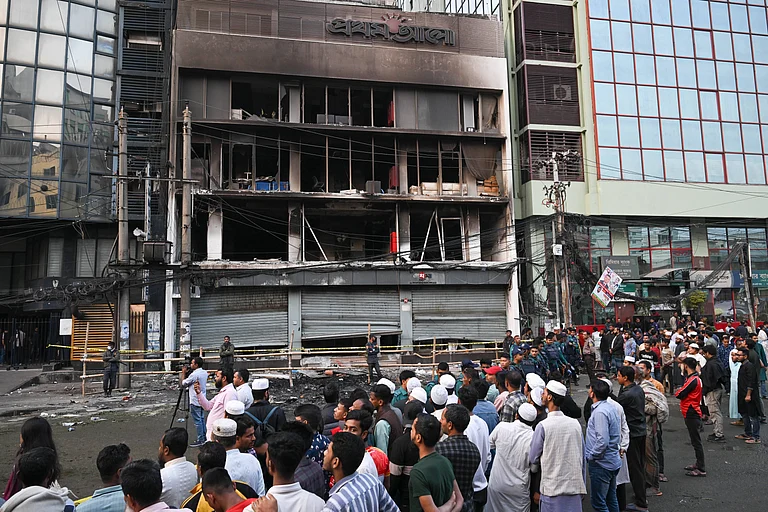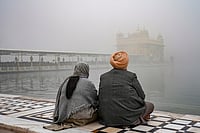Located in the Pynursla development block of the East Khasi Hills district, Mawlynnong stretches along the India-Bangladesh border. Declared the ‘Cleanest Village in Asia’ this tropical paradise is still at the top of its game when it comes to cleanliness and green initiatives. Made up of a hundred households, this little village is a stellar example of a community-based eco-tourism initiative. Villagers take turns cleaning the roads, and there is zero tolerance towards littering. The use of plastic is strictly prohibited, and smoking has also been banned here.
The drive to this gorgeous village passes through what seems like a montage of landscapes: showcasing the topographical diversity of Meghalaya. Table-top mountain ranges and roadways threading the edge of gorges give way to broom grass plantations and a more tropical setting. Picture-perfect paths fringed with hedges and flowers as well as ornamental plants welcome visitors to the magical village of Mawlynnong, which is aptly known as ‘God’s own Garden’.

Upon arriving in the village, you will come across typical straw-roofed Khasi huts and a few brick-and-mortar houses, with their walls covered in leafy vines and patios full of multi-coloured orchids. Most households have their vegetable gardens, and some even have a barn, with hens and roosters clucking contentedly. Along the way, you might also notice rocks with basins carved in them – a clever innovation by the locals to harvest rainwater. Conical bamboo baskets to collect trash can be found every few steps.
During the rainy season, the village is a sight to behold, with cottony low-lying mist enveloping the viewpoints on treetops; exotic butterflies fluttering amidst flowers; beautiful gardens; and rain-washed pathways leading to secluded nooks, utterly perfect for soak- ing in the idyllic scenery. Here are four experiences that you should not miss in Mawlynnong:
Visit the Church of Epiphany

A short walk from the car park in Mawlynnong takes you to this landmark church, which was founded in 1902. A flagstone path flanked by bushes leads to its well-manicured lawns, lined with palm trees. At the centre of these grounds stands this elegant red-roofed edifice, with a striking Gothic spire and stained-glass windows. Adjacent to the church is an observation deck on a treetop, from where you can enjoy panoramic views of the village.
Climb the Living Root Bridge

A bio-engineering marvel, living root bridges are unique to the state of Meghalaya. The one in Riwai is the most easily accessible of all these bridges. Once you reach Riwai, it is an exciting scramble through a forest to the root bridge. All along the way, you will see an array of dragonflies and butterflies, and crabs scuttling about in the dirt. At the end of the trail is a long flight of moss-slickened stone steps leading down to the bridge. The area around these steps gets slushy and somewhat treacherous during the rainy season, so be careful while negotiating this stretch. The single-decker root bridge in Riwai spans over a gushing stream. The sight of the gnarled living roots of the rubber fig (Ficus elastica) expertly manipulated by the locals to create this bridge will remind you of JRR Tolkien’s fictional world of Middle earth. This technique of fashioning a bridge from the secondary roots of the rubber fig (Ficus elastica) was developed by Khasi villagers to cross rough terrains, valleys and rivers. it takes between 10 to 15 years for a root bridge to become fully functional. Each year, villagers remain on the lookout for fresh roots that can be meshed into the extant intricate network of roots holding the bridge. This is how the bridge becomes increasingly resilient over time. Volunteers are posted on either side of the banks to regulate the movement of tourists across the bridge. During the dry season, you can even go down to the water for a dip.
Witness Skyview in Nohwet

A steep flight of precariously positioned stone steps flank the Living Root bridge. Signposted as the ‘Way to Skyview’, these steps lead to the quaint hamlet of Nohwet, where lies this unique viewing platform. Alternatively, visitors can take the concrete stairway, which also leads up to the village. Perched on the edge of a cliff, Skyview is an observation deck soaring to a height of around 70–80ft. Made of bamboo poles securely fastened with coir ropes, this seemingly fragile looking structure can hold up to seven people at a time. On a clear day, the viewing deck affords dramatic views of the Bangladesh plains, framed by the thick upper canopy of the forests in the region. The deck also has a few bamboo benches, where you can rest for a few minutes whilst admiring the spectacular scenery. to ensure the safety of visitors, the bamboo bridge and viewing platform are built anew every year, owing to the damage borne by the structure during the monsoon. You can also climb up to the Tree House – right next to the rickety bridge leading to the Skyview – for 360-degree views of the village and the surrounding hills and valleys. On your way back from the Skyview, take a stroll around the village for a glimpse into the life of the locals. Round off the visit with a steaming cup of red tea at one of the roadside tea stalls.
Unwind at Mawkyrnot
The road to Mawlynnong from Shillong is enchanting and filled with many possible detours. The Mawlynnong Living Root bridge may be one of the most popular but there are quite a few more in the Pynursla region. if you want to see these bioengineering wonders in a completely primaeval setting amidst thick jungle, then stop at Mawkyrnot village, a few kilometres south of Pynursla town. A short hike downhill will introduce you to three main living root bridges that span a small valley and waterfall. Apart from these main attractions, the descent itself will take you into the heart of these verdant ranges where the silence of the forest provides an incomparable calm.





















